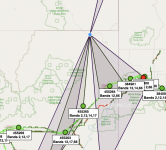I definitely recommend using CellMapper or a similar tool when trying to use a booster like this. Cell phone antennae are highly directional and what's not commonly discussed is that this applies to the towers as well as the device. Not only do you need to be aimed at a tower that matches your carrier but IT has to be aimed at YOU. Here's a good example, from the Book Cliffs in Utah where I camped recently. This is an AT&T tower that shows green signal all along I-70 but in the hills there was zero signal. A Weboost is not going to help at all here:
View attachment 66091
I moved a little further up the road I was camping on and was able to get closer to this guy:
View attachment 66092
As you can see there are a lot of dead areas here, if you camp in that empty area in the middle you're not going to get any service. Note that these are all for AT&T. Verizon, Sprint, and T-Mobile had nothing here. You can roam on other carriers but it's still best if the coverage matches your device.
The Weboost isn't perfect and I don't get anything for saying this. But my 2c if I'm careful about how I aim it, make sure the 30' antenna is fully extended, and am careful where I camp, with some pre-planning I can always count on service. It typically gives me 2 bars in places where I would otherwise have "no service", enough for low-bandwidth 3G usage (calls, texts, and maybe occasional things like weather updates) and 3-4 bars (enough for moderate Internet usage) in places where I would have 1 bar and almost no data. As always, YMMV.



